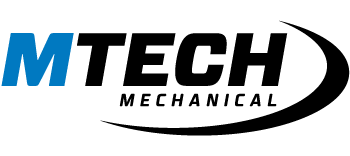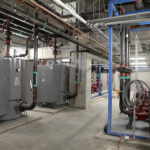Navigating HVAC Upgrades: A Comprehensive Guide
By Jessica Kash, Senior Service Account Manager
As property managers strive to meet tenant needs, meet performance requirements, manage budgets, etc., it is crucial to have an HVAC partner, not just a provider. In this article, we will delve into key considerations for property managers when planning HVAC upgrades, with a focus on obtaining best value, energy efficiency, effective communication, and equipment upgrades.
Energy-efficiency goals. Energize Denver and Colorado’s Building Performance Program have been hot topics over the past year. It’s important that as a building owner or property manager you understand these new building performance requirements. Hiring a local partner provides an opportunity to get ahead of these requirements.
Energy audits and assessments. Before embarking on HVAC upgrades, conduct a thorough energy audit to identify opportunities to improve inefficiency. This assessment will pinpoint opportunities for improvement and guide the selection of upgrades that align with energy-efficiency goals. Collaborate with certified energy auditors to ensure accurate evaluations.
This is a requirement for any equipment upgrades where more than one piece of HVAC equipment is being replaced. This rule is enforced for pulling permits on Colorado buildings 50,000 square feet or larger, and buildings with a footprint of 25,000 sf or larger in the city and county of Denver.
Consult with an accredited firm from the state of Colorado website to learn about your energy use intensity goals. The city and state will be implementing large fines on buildings that do not meet their EUI targets, so do your research today.
Smart HVAC controls. Implementing smart HVAC controls can significantly enhance energy efficiency. Smart thermostats, for instance, allow for precise temperature control and scheduling, optimizing energy consumption. These controls can be integrated into a centralized management system, providing property managers with real-time data and insights.
Working with a controls contractor, you can set up occupied and unoccupied schedules so that your equipment is only providing comfort cooling when your space is occupied. This will directly lower your energy bills because your building consumes less energy.
Energy-efficient equipment. Consider replacing outdated HVAC equipment with energy-efficient models. High-efficiency furnaces, air conditioners, and heat pumps can substantially reduce energy consumption while maintaining or even improving overall performance. Look for equipment with the Energy Star label, indicating compliance with strict energy-efficiency guidelines.
Many property managers are now looking into variant refrigerant flow systems and dual-fuel heat pumps (an electric heat pump with a gas heat back up for days where the temperature drops below the range the heat pump runs efficiently) as options for replacing existing rooftop units. These types of equipment investments substantially cut down on energy usage, which are helping
building owners reach their EUI goals outlined by the state.
Tenant engagement. Effective communication with tenants is vital during HVAC upgrades. Keep residents informed about the upcoming changes, potential disruptions, and the benefits they can expect. Utilize newsletters, emails, and community meetings to create awareness and set expectations.
Regular updates. Provide regular updates to your occupants on the progress of HVAC upgrades. Transparency builds trust among tenants and minimizes concerns about potential inconveniences. Clearly communicate any temporary disruptions and outline the long-term benefits of the upgrades, such as improved indoor air quality and reduced utility costs.
Collaboration with contractors. Establish clear lines of communication with HVAC contractors. Regular meetings and progress reports ensure that everyone is on the same page, reducing the likelihood of misunderstandings. Encourage contractors to communicate directly with tenants when necessary, keeping them informed about specific timelines and any actions required
on their part.
ASHRAE (American Society of Heating, Refrigerating and Air-Conditioning Engineers) provides guidelines and recommendations for the life expectancy of HVAC equipment. These guidelines are crucial for building owners, facility managers, and HVAC professionals to plan for system replacements, upgrades and maintenance effectively. It’s important to note that actual equipment life can vary based on factors such as maintenance practices, operating conditions, and technological advancements.
Rooftop units. ASHRAE provides a general life expectancy of 15 years for rooftop units, which are commonlyused in commercial HVAC systems. Proper maintenance, including inspections and cleaning, is essential for extending the life of RTUs.
Chillers. The life expectancy of chillers depends on factors such as type, size and maintenance. According to ASHRAE, centrifugal chillers have an average lifespan of 20 to 25 years, while absorption chillers may last 25 years or more. Regular maintenance, water treatment and proper operation contribute to extended chiller life.
Controls and building automation systems. ASHRAE does not provide specific guidelines for the life expectancy of controls and building automation systems. However, advancements in technology may lead to the need for upgrades or replacements every 10 to 15 years to ensure compatibility with newer equipment and energy-efficiency standards.
In conclusion, HVAC upgrades present property managers with a valuable opportunity to enhance energy efficiency, reduce operational costs and improve tenant satisfaction. By focusing on improved energy goals, implementing effective communication strategies, and embracing equipment upgrades, property managers can create a sustainable and comfortable living environment for their tenants. As the real estate industry continues to prioritize sustainability, these HVAC upgrades will contribute not only to immediate energy savings but also to the long-term value and viability of the property.
First Published in Colorado Real Estate Journal – Property Management Quarterly – January 2024




